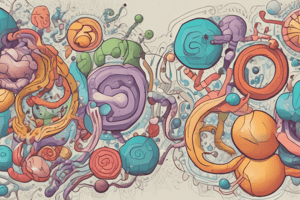Podcast
Questions and Answers
Which of the following is NOT a role of protein in the body?
Which of the following is NOT a role of protein in the body?
- Hormone production
- Muscle growth and repair
- Energy production (correct)
- Immune system function
All amino acids are essential and must be obtained through diet.
All amino acids are essential and must be obtained through diet.
False (B)
What are the two main types of nucleic acids?
What are the two main types of nucleic acids?
DNA and RNA
The three-dimensional shape of a protein is referred to as its ______ structure.
The three-dimensional shape of a protein is referred to as its ______ structure.
Which type of fiber dissolves in water?
Which type of fiber dissolves in water?
Match the following protein structures with their descriptions:
Match the following protein structures with their descriptions:
Fiber can be completely digested by the human body.
Fiber can be completely digested by the human body.
How many different types of amino acids are there?
How many different types of amino acids are there?
What is the primary function of enzymes?
What is the primary function of enzymes?
DNA consists of a single-stranded helix.
DNA consists of a single-stranded helix.
What do the letters A, T, G, and C represent in the context of DNA?
What do the letters A, T, G, and C represent in the context of DNA?
Proteins are made up of ______, which are connected by peptide bonds.
Proteins are made up of ______, which are connected by peptide bonds.
Match the following types of RNA with their functions:
Match the following types of RNA with their functions:
Which structure of proteins refers to the sequence of amino acids?
Which structure of proteins refers to the sequence of amino acids?
Proteins play a significant role in the immune system.
Proteins play a significant role in the immune system.
Name one type of protein involved in the transport of oxygen.
Name one type of protein involved in the transport of oxygen.
Flashcards
Protein's role
Protein's role
Protein is essential for body functions like muscle repair and hormone production.
Essential Amino Acids
Essential Amino Acids
Amino acids the body can't make, need to be in diet.
Protein structure: Primary
Protein structure: Primary
The order of amino acids in a protein chain.
Protein structure: Secondary
Protein structure: Secondary
Signup and view all the flashcards
Soluble Fiber
Soluble Fiber
Signup and view all the flashcards
Insoluble Fiber
Insoluble Fiber
Signup and view all the flashcards
Nucleic Acid Function
Nucleic Acid Function
Signup and view all the flashcards
DNA Role
DNA Role
Signup and view all the flashcards
What are proteins?
What are proteins?
Signup and view all the flashcards
What's the role of amino acids in proteins?
What's the role of amino acids in proteins?
Signup and view all the flashcards
How are different proteins classified?
How are different proteins classified?
Signup and view all the flashcards
What are nucleic acids?
What are nucleic acids?
Signup and view all the flashcards
What are nucleotides?
What are nucleotides?
Signup and view all the flashcards
What is DNA's role?
What is DNA's role?
Signup and view all the flashcards
What does RNA do?
What does RNA do?
Signup and view all the flashcards
What are the types of RNA?
What are the types of RNA?
Signup and view all the flashcards
Study Notes
Importance of Protein
- It is an essential nutrient for the human body
- It plays a crucial role in various bodily functions, including muscle growth and repair, hormone production, and immune system function
- Protein is crucial for building and maintaining healthy tissues
Types of Proteins
- Proteins are composed of amino acids
- There are 20 different types of amino acids
- Some amino acids are essential meaning that the body cannot make them and must be acquired through diet
- Others are nonessential and can be synthesized by the body
Protein Structure
- There are four levels of protein structure
- Primary Structure: refers to the linear sequence of amino acids in a polypeptide chain
- Secondary Structure: refers to the local folding of the polypeptide chain into structures such as alpha-helices and beta-sheets
- Tertiary Structure: refers to the overall three-dimensional shape of a single polypeptide chain
- Quaternary Structure: refers to the arrangement of multiple polypeptide chains (subunits) to form a functional protein.
Importance of Fiber in Diet
- Fiber is a type of carbohydrate that the body cannot digest
- It is important for digestive health, promoting regular bowel movements and preventing constipation
- Fiber can also help lower cholesterol levels and regulate blood sugar
- Types of fiber include soluble and insoluble.
- Soluble fiber dissolves in water and forms a gel-like substance in the digestive tract.
- Examples are pectin, found in fruit, and beta-glucan, found in oats.
- Insoluble fiber does not dissolve in water and adds bulk to the stool.
- Examples include cellulose, found in vegetables, and lignin, found in wheat bran.
Nucleic Acids
- Nucleic acids are essential biomolecules present in all living organisms
- The two main types of nucleic acids are deoxyribonucleic acid (DNA) and ribonucleic acid (RNA).
- DNA is the genetic material of an organism, containing the instructions for building and maintaining an organism.
- RNA is involved in protein synthesis, transferring genetic information from DNA to ribosomes where proteins are made
- Nucleic acids are composed of nucleotides, which are made up of a sugar, a phosphate group, and a nitrogenous base.
- There are five nitrogenous bases found in nucleic acids: adenine (A), guanine (G), cytosine (C), thymine (T), and uracil (U).
Importance of Nucleic Acids
- Nucleic acids are essential for life as they carry the genetic information that determines the traits of an organism.
- They are used in the production of all proteins, enzymes, and other essential molecules.
- Mutations in nucleic acids can lead to genetic disorders.
Studying That Suits You
Use AI to generate personalized quizzes and flashcards to suit your learning preferences.




